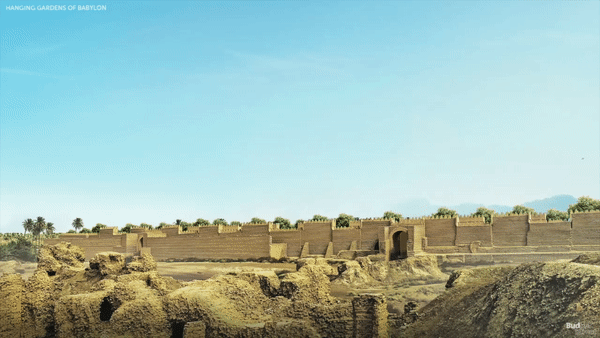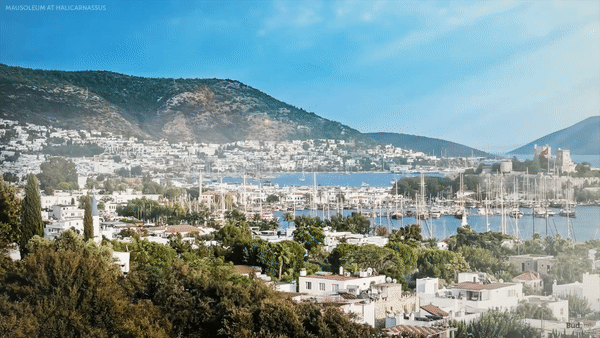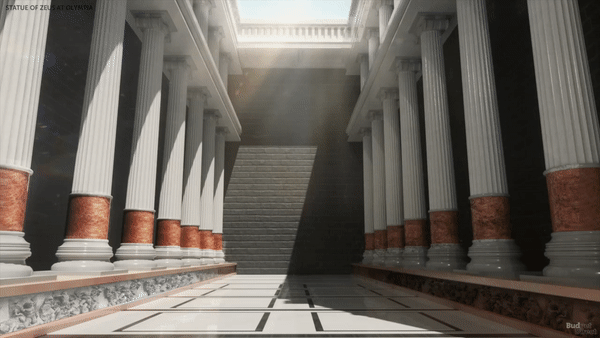Finally technology is being put to good use!
The 7 Wonders of the Ancient World was a list of must-see sites for Ancient Greek tourists. Compiled by Antipater of Sidon, a poet in 2nd-century-BCE Greece, with later contributions by figures such as the mathematician Philon of Byzantium, the list remains an important piece of intangible heritage today.
Sadly, only one of those ancient wonders is still standing. Fortunately technology has come to the rescue so that modern classics-lovers can have the chance to visit the structures that Antipater first recommended.
Check out the reconstructed the 7 Wonders of the Ancient World, so you can see how the ruins originally looked:
A feat of ingenuity and engineering and served as a Rhodian symbol of victory. The Colossus of Rhodes was erected in 280 BCE but was toppled by an earthquake in 226 BCE.

2. The Great Pyramid of Giza
The oldest and largest of the three pyramids in the Giza pyramid complex bordering present-day El Giza, Egypt. It is the oldest of the Seven Wonders of the Ancient World, and the only one to remain largely intact.

3. Hanging Gardens of Babylon
An ascending series of tiered gardens containing a wide variety of trees, shrubs, and vines, resembling a large green mountain constructed of mud bricks, and said to have been built in the ancient city of Babylon, near present-day Hillah, Babil province, in Iraq.

4. Lighthouse of Alexandria
A lighthouse built by the Ptolemaic Kingdom, during the reign of Ptolemy II Philadelphus (280–247 BC), and was estimated to be 100 metres (330 ft) in overall height. For many centuries it was one of the tallest man-made structures in the world.

5. Mausoleum at Halicarnassus
A tomb built between 353 and 350 BC at Halicarnassus (present Bodrum, Turkey) for Mausolus, a satrap in the Persian Empire, and his sister-wife Artemisia II of Caria. The structure was designed by the Greek architects Satyros and Pythius of Priene.

A giant seated figure, about 13 m (43 ft) tall,[1] made by the Greek sculptor Phidias around 435 BC at the sanctuary of Olympia, Greece, and erected in the Temple of Zeus there. It represented the god Zeus on a cedarwood throne ornamented with ebony, ivory, gold and precious stones. Lost in the 5th AD.

7. Temple of Artemis at Ephesus
A Greek temple dedicated to an ancient, local form of the goddess Artemis (associated with Diana, a Roman goddess). It was located in Ephesus (near the modern town of Selçuk in present-day Turkey). It was completely rebuilt three times.

Pretty exciting results!
Of course to get these excellent images, researchers commissioned by budgetdirect had to find extensive visual and written information on each wonder; including when it was built, which civilization built it and for what purpose. They gathered information around the specific features of each wonder; such as building materials, measurements and key architectural features. These details were then backed up with hi-resolution images of drawings, sketches or any other available imagery in the archives. Once this research was compiled, it was passed along to architectural design duo Keremcan Kirilmaz and Erdem Batirbek, under the guidance of NeoMam’s art director.
The final Photoshop files were sent to motion graphics artist Fractal Motion, who were in charge of creating the animations. This complex process involves dividing up the images, then animating them using a tool in Cinema 4D software called Polyfx before refining it all in After Effects.








One comment
Awesome job, I loved seeing these ancient wonders as they probably looked when they were completed. Thanks for the hard work.
Our apologies, you must be logged in to post a comment.